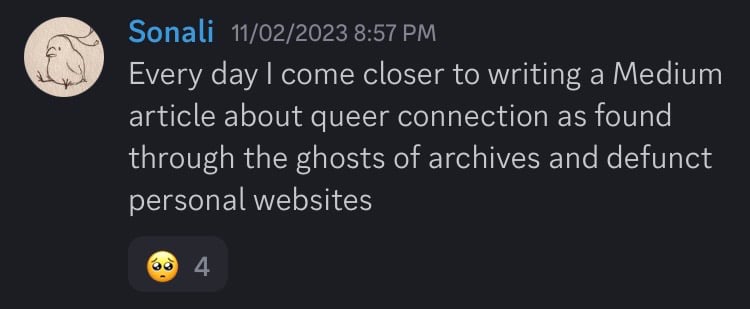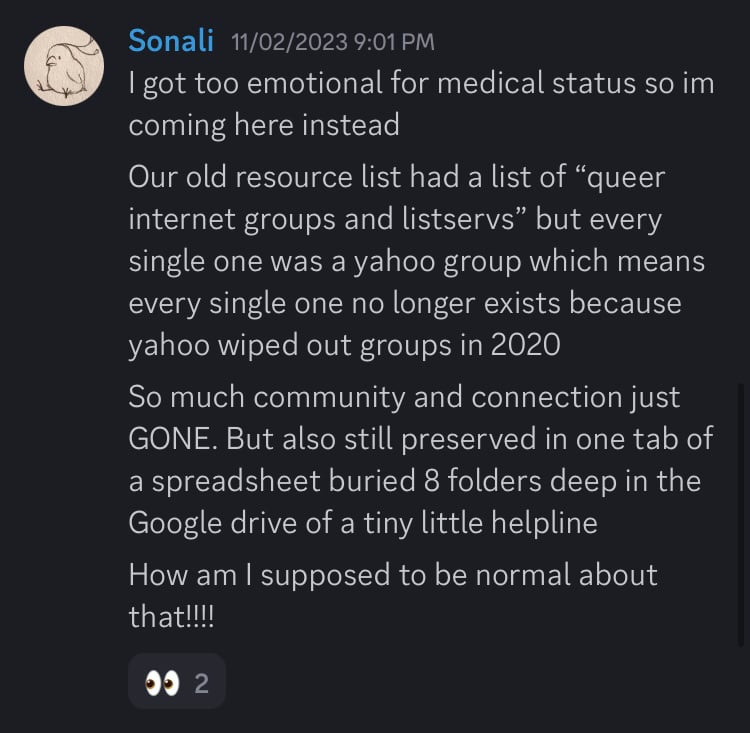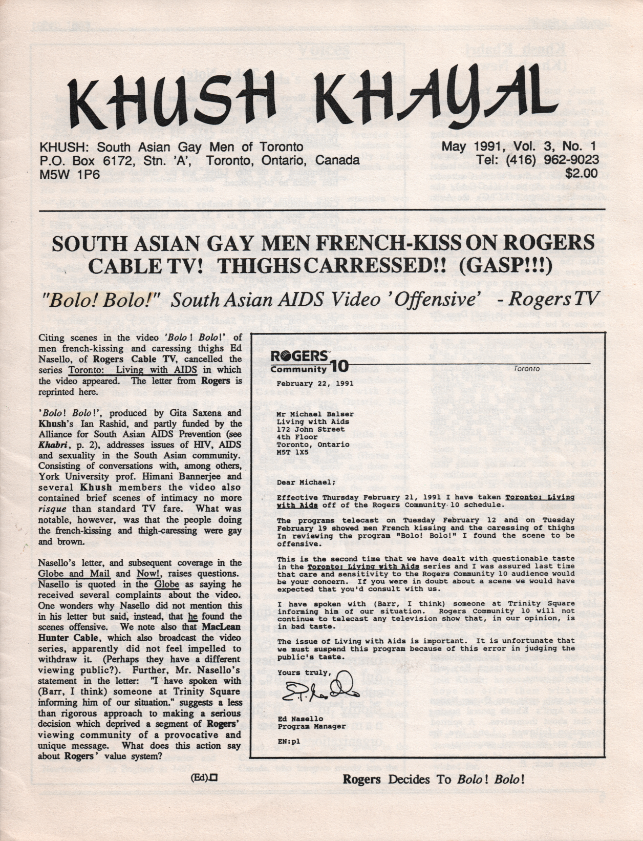#5: A reflection on existence as a radical act
Hi friends. This email is a culmination of a number of trains of thought that I’ve been chewing on for a few years. It’s a little heavy, and a lot long, and it includes discussions of queer history, the election, and mentions of queerphobia. If that’s not for you, I totally understand! I’ll see you for the next dose of whimsy in next month’s newsletter.
(As a side note, shoutout to Annabelle for her own long post-election blog post that inspired me to finally get this typed up! Go check out her newsletter too in the noble pursuit of bringing back the days of yore Web 2.0.)

If you’ve known me for any number of years, you likely know that I volunteer with a peer support helpline for queer South Asians. It’s a small outfit, founded in 2012—we have a dozen volunteers in our best years, and just 4 or 5 in the worst.
I joined the helpline in 2021 and, in typical Sonali fashion, threw myself into as many projects as I could. The most enduring of these has been revamping the helpline’s resource directory, a Google Sheet compiled in 2012 with more than 700 websites, publications, national and local organizations, support groups, health care providers, and individual queer/AAPI allies listed in its shoddily formatted tabs. Numerous upheavals and periods of barebones capacity over the years had led to the resource directory being placed on the backburner, and it stopped being updated sometime around 2016. By 2021, the directory was rife with broken links and outdated information, rendering it functionally useless. So I undertook the gargantuan task of combing through the directory, updating all the information, adding a tagging system, and generally bring it into the modern day.
Y’all… The 3-year journey of updating this resource directory has taken me on an indescribable roller-coaster of emotions. I’d like to share some of those emotions with you now, because if I have to keep them inside of me forever, I will actually explode.

Right off the bat, the sheer number of personal websites and poorly coded HTML slammed me with nostalgia for Web 2.0. So many of the resources listed in the directory were passion projects created solely to reach niche groups of queer folks, like HAM radio enthusiasts or cross-dressers in California. Crusty graphics and misaligned containers ran rampant; so long as you could click the buttons and find the date for the next meet-up, these websites could not care less about their aesthetics.
I miss Web 2.0 every single day. I never shut the hell up about missing Web 2.0. I miss forums; I miss gimmick websites; I miss the fun widgets and I miss StumbleUpon and I miss ProjectFreeTV. So discovering that this resource directory was basically a portal straight back to the halcyon neon days of Web 2.0 already had me feeling some type of way.
And then I started looking at the websites themselves. Some of the resources listed in the directory date back to the late ‘70s. There were dozens of websites run by queer individuals just sharing their thoughts and experiences. There were archives of resources and event calendars collated because no one else had done that work yet. There were queer community meetup sites; queer housing sites; queer traveling and camping sites; queer zines and queer films and queer resource swaps and queer mutual aid. Advocacy groups and grassroots organizations and HIV/AIDS service providers, all dating back nearly half a century. And not just in America, but in India, too, and Pakistan, and other South Asian communities throughout the world, existing in the face of the notorious conservatism that characterizes South Asian countries even today. A patchwork quilt of queer and South Asian experience—of queer and South Asian life—collaged out of scraps of community, sewn together by the threads of time. Every single resource was an example of another queer person determinedly carving out space for themselves, insisting on their right to exist, and often extending a hand to a group of people to whom no hand had ever been extended before.

It took my breath away. It still takes my breath away every time I revisit the directory. It’s one thing to read the history, to know objectively that queer people have always existed and found each other and built community together. It’s another to see the whole, tangible, vast matrix of queer existence laid out in an Excel grid.
And it’s a third thing altogether to realize that you’re weaving yourself into that tapestry, too. Looking through these resources wasn’t a passive act; it was an active interaction. In trawling these sites and porting information about these resources to the new directory, I was both tying these resources indelibly to the helpline and preserving the record of their existence, helping to keep them alive just a little longer.
Because the flipside, of course, is that for every organization that’s been around since the ‘80s, there are twice as many that shuttered in that time, whether due to lack of funding, diminished operational capacity, political pressure, or even the death of the resource’s founder. I never knew what the fate of a resource would be when I clicked the link. Oftentimes the link itself would be defunct, and I would have to embark on an expedition to unearth the evolution of the resource since its inception: would I find that it had simply changed URLs and migrated to a new hosting service, or would I find a single blog post from an independent publication noting without fanfare that the resource had suspended operations in 20XX?
These instances took my breath away, too, this time by punching me with grief. Is it dramatic to grieve the loss of pieces of community that were born and died before I was even a sparkle in my parents’ eyes? Maybe. But how could I not ache for the erasure of so much queerness, lost forever to the digital ether? And not just queerness, but records of individual human experience and human joy?
Occasionally I was able to find archives dedicated to keeping some of these projects alive, and some organizations were at least memorialized in Wikipedia stubs and news features, but all told, nearly 150 resource listings had stopped existing in any capacity by 2021. 150 instances of queer community that, unless you stumbled upon a memorial in a zine, no one would ever know had once existed.
But I knew. Because these resources, and knowledge of the people who had founded and run them, had been kept alive by our dinky little spreadsheet. Realizing I was probably the first person in a decade to revisit some of these now-defunct resources? Yeah, that made me cry a bit, too.
Even now, after 3 years of sitting with these feelings and picking them apart and screaming about them on Discord, it’s hard to explain the intensity of the emotional cocktail I feel whenever I’m working on this directory. After all, the world is different now. Corporations turn rainbow every June, and gay marriage is legal, and there are queer couples in mainstream media. Moreover, I live in New York City. I'm not exactly wanting for queer representation and community.
So why does it still feel like I’m being hit by a train every time I dive into one of these resources?

I think what it comes down to is that inside of me exists, still, the scared teenager that lost half her friends in high school and got dirty looks in the halls because she had a girlfriend. A teenager whose only hope of surviving to see the next day was to be so loudly, proudly queer that she couldn’t hear any of the bigots.
And inside of me exists, as well, the dumbfounded woman who just found out that my being proud of my queerness in Oklahoma in 2014 had helped empower a younger Indian girl in the same town to accept her own queerness in 2020. An impact 6 years removed from the initial impetus; an impact made sheerly by existing.
And I can’t help but feel like the people in this resource directory, the people who have been visibly queer since the 70s and 80s and 90s, are to me what I was to that little girl. Their existence enabled mine. Their pride inspires mine. I am so unbelievably grateful, and proud, and awed, that they existed, and that knowledge of their existence withstood the tests of time and digital erosion long enough to reach me.
I think about this resource directory all the goddamn time, not least because it’s taken 3 years to finish pruning it. It’s been on my mind even more so in the wake of the recent election.
Because let’s be real, things are probably going to suck. I don’t know what the future holds, and I’m not equipped to provide any sort of answers on how to respond and cope. (Though I did find this article and this Tumblr thread personally resonant, if you’re in the market for that sort of thing.)
What I do know that is even when I was doomscrolling and gloomposting, I was also thinking about Debra Davis and the Purple Circuit and Khush Khayal. I kept thinking about how profound it felt to stumble upon these projects, which had been founded and maintained even in the face of persecution. I kept thinking about how the founders of those projects had no clue that in 20 or 30 or 40 years, a queer Indian enby would stumble upon them and find inspiration in their existence. And I thought, sometimes it is enough just to exist.
In a country that seems to want us dead, existing is an act of resistance. Our continued presence in this hostile ecosystem is an act of protest. Our survival is itself a form of defiance, a hand held out to the Sonalis of 20, 30, 40 years from now, who might someday trace their own history through the decades and marvel at the sheer vastness of queer existence.